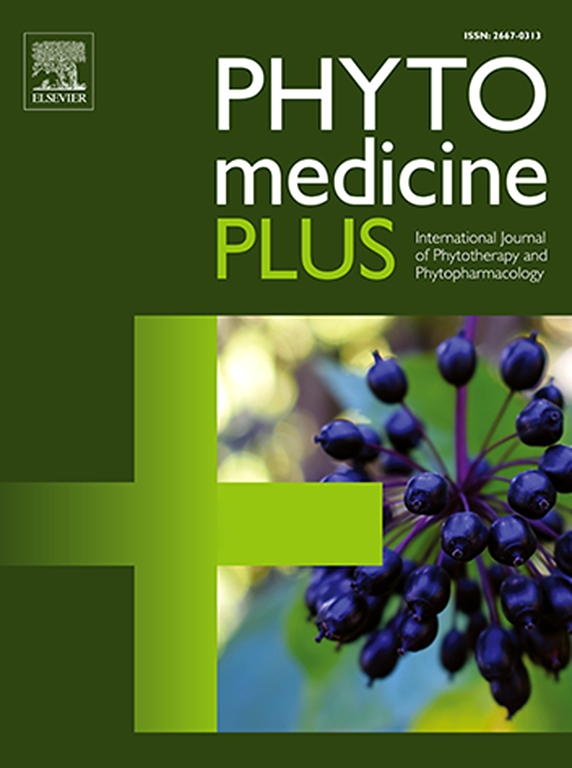The anticancer properties, cell-cycle cytotoxicity and apoptosis of cissus rotundifolia, trema orientalis, and buddleja polystachya with ocular applications
Q3 Pharmacology, Toxicology and Pharmaceutics
引用次数: 0
Abstract
Background
Buddleja polystachya, Trema orientalis, and Cissus rotundifolia were applied locally for various ocular purposes, while receiving few scientific evaluations.
Purpose
This study aimed to screen the anticancer properties and determine the cell-cycle cytotoxicity and apoptotic activity of the most promising plant extract.
Methods
In this study, MTT assays with MCF7 (human breast adenocarcinoma), HT29 (human colorectal adenocarcinoma) and HepG2 (human liver adenocarcinoma) were used. In addition to MRC5 (normal human foetal lung fibroblast) was carried out for preliminary activity screening and selectivity. The most promising extract was subjected to GC–MS analysis to determine the phytochemical composition. Additionally, a clonogenic assay was performed to measure tumor cell survival and subsequent proliferative capacity after drug exposure was conducted for the most active extract(s) and finally western blotting was used to determine the expression change of the two selected proteins (survivin and CCND1) in order to determine the exact mechanistic features of the most promising plant extract.
Results
The six extracts showed variable IC50 values ranging from 1.77 to - 40.97 μg/mL. The most active extracts were C. rotundifolia coded as (stem; BEP-03A and leaves; BEP-03B) on HepG2 cells and showed ∼ 4 and 8 fold selectivity compared to normal MRC5 cells. Both extracts showed a dose-dependent clonogenic effect on HepG2 cells, which was comparable to the effect of doxorubicin. The extract (BEP-03B) caused a significant decrease in the expression of survivin and CCND1 compared to the control GAPDH at its highest dose (12 µg/mL). The GC–MS chromatogram of the leaf of C. rotundifolia extract (BEP-03B) revealed the presence of 17 compounds, as the main phytoconstituents representing 57.5 % of the total compounds present in BEP-03B Three steroidal components (12, 14 and 15) were the main components, while compound stigmast-5-en-3-ol (compound 15) was the main component.
Conclusions
Leaves of Cissus rotundifolia (Forssk.) Vahl, possess a significant cytotoxic effect and it may produce this effect, through apoptosis induction, perturbation, and disruption of the cell cycle. The detected phytoconstituents in the plant extract might be involved in the tested cytotoxic activity and its molecular apoptotic mechanism. Future studies are required to isolate the active ingredient(s) and confirm the therapeutic application(s).

圆叶仙子、东方trema和多穗花的抗癌特性、细胞周期、细胞毒性和细胞凋亡与眼部应用
研究背景:水仙、东方Trema orientalis和圆叶仙子被广泛应用于眼部,但科学评价较少。目的筛选具有较好应用前景的植物提取物的抗肿瘤活性,测定其细胞周期、细胞毒性和细胞凋亡活性。方法采用MCF7(人乳腺腺癌)、HT29(人结直肠腺癌)和HepG2(人肝腺癌)的MTT检测。此外,对MRC5(正常人胎儿肺成纤维细胞)进行初步活性筛选和选择性。采用气相色谱-质谱分析确定了最有希望的提取物的植物化学成分。此外,对最有效的提取物进行了克隆测定,以测量药物暴露后肿瘤细胞的存活率和随后的增殖能力,最后使用western blotting测定两种选定蛋白(survivin和CCND1)的表达变化,以确定最有希望的植物提取物的确切机制特征。结果6种提取物的IC50值在1.77 ~ - 40.97 μg/mL之间。活性最强的提取物为圆叶C.(茎);BEP-03A和叶片;BEP-03B)作用于HepG2细胞,与正常MRC5细胞相比,显示出4倍和8倍的选择性。两种提取物对HepG2细胞均表现出剂量依赖性的克隆生成作用,其效果与阿霉素相当。在其最高剂量(12 µg/mL)下,与对照GAPDH相比,BEP-03B提取物显著降低了survivin和CCND1的表达。经GC-MS分析,黄叶提取物(BEP-03B)的主要成分为17种化合物,占总化合物的57.5 %,其中甾体化合物(12、14和15)为主要成分,化合物15为主要成分。结论:圆叶仙鹤(Forssk.;Vahl具有显著的细胞毒性作用,它可能通过诱导细胞凋亡、扰乱细胞周期和破坏细胞周期来产生这种作用。植物提取物中检测到的植物成分可能参与了所测细胞毒活性及其分子凋亡机制。需要进一步的研究来分离活性成分并确认其治疗应用。
本文章由计算机程序翻译,如有差异,请以英文原文为准。
求助全文
约1分钟内获得全文
求助全文
来源期刊

Phytomedicine Plus
Medicine-Complementary and Alternative Medicine
CiteScore
3.70
自引率
0.00%
发文量
178
审稿时长
81 days
期刊介绍:
 求助内容:
求助内容: 应助结果提醒方式:
应助结果提醒方式:


